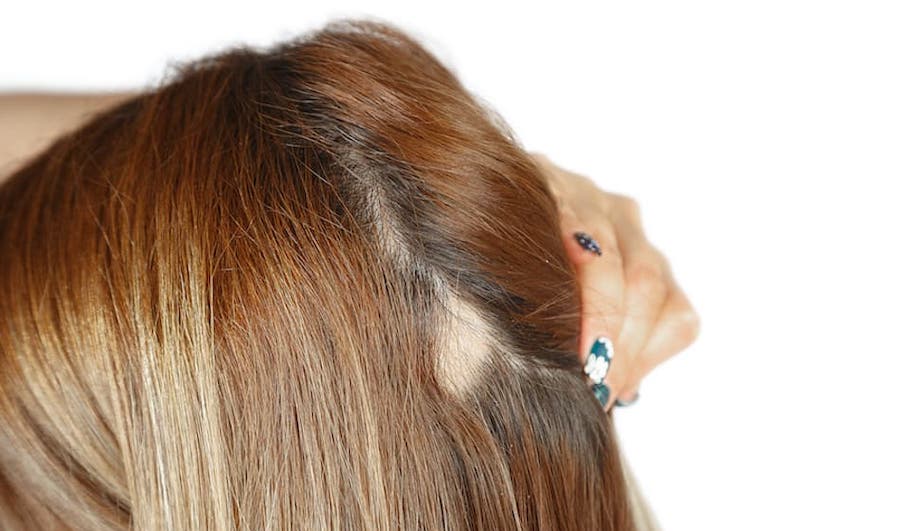
Alopecia Areata: Causes, Symptoms, Diagnosis and Treatment
There are nearly 7 million people in the United States who suffer from alopecia areata, an autoimmune disease that causes hair loss.
But what causes it? Is there a cure?
This comprehensive guide aims to shed light on all aspects of alopecia areata, from understanding its types and recognizing its symptoms to exploring treatment options and living with the condition.
Short Summary
-
Alopecia areata is an autoimmune disorder causing varying degrees of hair loss, with four forms and multiple treatment options.
-
Identifying risk factors, recognizing symptoms, and seeking diagnosis & treatment can help manage the condition.
-
Resources & support from organizations like NAAF provide education to those living with alopecia areata.

I LOVE MY HAIR NOW
FullyVital hair serum and hair vitamins made tremendous improvements in my hair. I truly love my hair now.
Dorit S.,
Understanding Alopecia Areata
There are different types of hair loss.
One of the less common types is alopecia areata, an autoimmune condition that turns your own immune system against you, causing it to attack your hair follicles.
The result? Hair loss, varying in severity from patchy spots on the scalp to complete baldness all over the body. Alopecia areata can be quite unpredictable, with some people experiencing a single episode and others dealing with recurring bouts of hair loss and regrowth.
This disease comes in different forms. There are three main forms of alopecia.
-
Patchy alopecia areata: This is the most common form, characterized by one or more coin-sized patches of hair loss on the skin or body.
-
Alopecia totalis: This form results in the complete loss of hair on the scalp.
-
Alopecia universalis: This form results in the complete loss of hair on the scalp and the entire body.
Meanwhile, diffuse alopecia areata manifests as sudden thinning of hair across the scalp.
Alopecia areata is different from female pattern baldness, which is primarily caused by hormones.
Patchy Alopecia Areata
In the case of patchy alopecia areata, the immune system attacks the hair follicles in certain areas, causing circular patches of hair loss. These patches, usually about the size of a coin, can appear on:
-
the scalp
-
beard area
-
eyebrows
-
eyelashes
-
even inside the nose
They are like unexpected bald islands in a sea of hair.
Despite its seemingly harmless nature, patchy alopecia areata can progress to more severe forms, causing more extensive hair loss.
However, there are treatments such as injections of corticosteroids, that can stimulate hair regrowth and offer hope to those affected.
Alopecia Totalis
Alopecia totalis is a form of alopecia areata that results in complete hair loss on the scalp, turning it into a smooth, hairless surface.
While the cause of alopecia totalis remains uncertain, it is believed to be an autoimmune disorder where the immune system mistakenly attacks the hair follicles.
However, even in the face of such a daunting condition, hope persists. While there is no definitive cure, hair regrows after the immune system ceases its attack on the hair follicles.
In this process, it may be possible to regrow hair, giving individuals a renewed sense of confidence.
Alopecia Universalis
The most severe form of alopecia areata is called alopecia universalis. It results in total hair loss not just on the scalp, but across the entire body, including eyebrows and eyelashes, making it the most dramatic form of severe alopecia areata.
In comparison, alopecia areata totalis leads to complete hair loss on the scalp alone. However, alopecia areata universalis takes it a step further, affecting the entire body.
Despite the extensive hair loss, treatments for alopecia universalis exist. Some of these treatments include:
-
Corticosteroids
-
Methotrexate
-
Topical minoxidil
-
Phototherapy
These treatments serve as glimmers of hope for those living with this condition.
And while it may cause permanent hair loss in some cases, others may experience the condition resolving itself after a few months or years.
Diffuse Alopecia Areata
Diffuse alopecia areata is characterized by an abrupt thinning of hair across the scalp, a less dramatic but equally disheartening form of hair loss.
The exact cause of diffuse alopecia areata remains unknown. However, it is believed to be an autoimmune disease, with the immune system mistakenly attacking the hair follicles. This condition is one of many autoimmune diseases that affect various parts of the body.
While it may not leave you completely bald, the thinning of hair can be a significant blow to self-esteem, making treatment and support crucial.
Diffuse alopecia is a different type of hair loss than telogen effluvium, though there can be some similarities.
Identifying Risk Factors
Several factors come together to determine who is at risk of developing alopecia areata. It’s not a simple one-cause disease, but rather a complex interaction of genes and environment.
The wheel of genetic predisposition may land on alopecia areata, especially if there’s a family history of autoimmune disorders.
Environmental triggers may also play a part, acting as the spark to the genetic tinder. Just as dry conditions and a single spark can ignite a wildfire, certain conditions in your body could trigger alopecia areata.
However, it’s important to remember that while we can identify these risk factors, alopecia areata remains an unpredictable disease.
Recognizing Symptoms
Alopecia areata can manifest in different forms, each with its unique set of symptoms. The most common sign is the appearance of one or more bald patches, which are the symptoms of alopecia areata, on the:
-
scalp
-
eyebrows
-
eyelashes
-
body
This is a clear indication that one may develop alopecia areata, as it is at work.
But alopecia areata is not just about physical symptoms. The sudden hair loss can also cause psychological distress, affecting the individual’s self-esteem and emotional well-being.
Therefore, recognizing these symptoms is the first step towards seeking help and managing the condition.
It's also helpful to rule out traction alopecia in the diagnosis.
Diagnosis Process
Alopecia areata diagnosis requires a bit of work. Doctors examine the pattern and history of hair loss, conduct a physical exam, and review the the patient’s medical history.
Sometimes, a scalp biopsy may be performed to rule out other potential causes of hair loss. This thorough process ensures an accurate diagnosis, leading to an effective treatment plan.
Treatment Options
While there’s no magic wand to make alopecia areata disappear, various treatment options can help treat alopecia areata, manage the condition, and stimulate hair regrowth.
Medications, including steroids and drugs used for other conditions like psoriasis, form a significant part of this toolbox.
Topical sensitizers are another option, acting as agents that stimulate the immune system to promote hair regrowth.
But the list of treatments is not fixed; it is expanding with ongoing research and emerging treatments like JAK inhibitors showing promising results.
Medications
Medications are like the first line of defense in the battle against alopecia areata. Steroids, usually in the form of injections, are often employed to stimulate hair regrowth, like encouraging seeds to sprout into saplings. These steroid injections are repeated every one to two months, maintaining a consistent defense against the disease.
Oral treatments, including cortisone tablets and immunosuppressants like methotrexate and cyclosporine, are available for more extensive alopecia. These medications work by suppressing the overactive immune response.
Topical Sensitizers
Topical sensitizers can be helpful against alopecia areata. Applied directly to the scalp, they work undercover to stimulate hair growth.
These agents, which include contact sensitizers such as dinitrochlorobenzene (DNCB), squaric acid dibutylester, and diphenylcyclopropenone, play a crucial role in helping individuals regain their lost hair and confidence.
Emerging Treatments
As research on alopecia areata advances, emerging treatments are entering the field, bringing new hope to those affected.
One such promising territory is the use of JAK inhibitors, medications that have shown efficacy in treating alopecia areata.
These medications, including drugs like baricitinib and ritlecitinib, are showing promising results in clinical trials, giving hope to those grappling with this condition.
Living with Alopecia Areata
Living with alopecia areata can be challenging, with the physical and emotional toll of hair loss.
There are also several practical solutions available to help mask the signs of alopecia areata. Some options include:
-
Wigs and eyelash extensions
-
Eyebrow stencils
-
Eyebrow pencil
-
Microblading
-
Eyebrow tattoos
These aids can help individuals regain their confidence.
Resources & Support
Resources and support are available to guide those living with alopecia areata. The National Alopecia Areata Foundation (NAAF) and the This Is Me Foundation help provide support, education, and funding for research to find a cure or effective treatment for alopecia areata.
These organizations also offer support groups, creating a community where individuals can share their experiences and learn from others.
Summary
From understanding the different types of alopecia areata to recognizing its symptoms, identifying risk factors, and exploring treatment options, we've identified that various factors involved in this condition.
While alopecia areata can be challenging for many individuals, with the right resources, support, and treatments, it is possible to mange the condition.
While the journey of living with alopecia areata is unique to each individual, remember that you are not alone. As research progresses and treatments evolve, there’s always hope on the horizon.
Frequently Asked Questions
What triggers alopecia areata?
It appears that emotional stress and illnesses can potentially trigger alopecia areata in susceptible individuals, but the cause is largely unknown.
What are 4 causes of alopecia?
Alopecia can be caused by genetics, physical stress, hormonal imbalances, and autoimmunity.
Other causes may include chemotherapy, radiation, fungal infections, and certain medications.
How I got rid of my alopecia areata?
To treat alopecia areata, corticosteroid medications are commonly used. These are anti-inflammatory drugs that suppress the immune system.
These are administered through local injections, topical ointment application or orally.
While they don't cure alopecia areata, most patients have some regrowth after taking these medications for 6 weeks.
How do you stop alopecia areata from spreading?
To stop alopecia areata from spreading, it is recommended to use corticosteroid injections or topical treatments like minoxidil. Both reduce inflammation and stimulate new hair growth.
What is alopecia areata?
Alopecia areata is an autoimmune disease that results in patchy or complete hair loss all over the body.
What are the common alopecia areata symptoms?
Common alopecia areata symptoms include one or more round, smooth patches of complete hair loss, usually on the scalp but can occur anywhere on the body.
Hair loss can be rapid, and the patches may increase in size. Occasionally, nails may show tiny dents (pitting) or a rough, sandpaper-like texture.
What are common alopecia areata treatments?
Common treatments for alopecia areata include corticosteroids (injections or topical creams) to reduce inflammation and promote hair regrowth, minoxidil (Rogaine) to stimulate hair growth, and anthralin to stimulate hair follicle activity.
For more severe cases, immunotherapy might be considered. Additionally, some patients use wigs or hairpieces while awaiting regrowth.
Is any treatment for alopecia areata FDA approved?
The U.S. Food and Drug Administration has given its approval for the use of Olumiant (baricitinib) oral tablets in the treatment of severe alopecia areata in adults.
Alopecia areata is a condition resulting in patchy hair loss, affecting over 300,000 individuals in the U.S. annually.
This decision signifies the first instance of the FDA approving a systemic (meaning it treats the whole body, not just a specific area) therapy for alopecia areata.
Are there any other types of hair loss types?
The other types of hair loss include traction alopecia and scarring alopecia.







